- Startseite
- Publikationen
- GIGA Focus
- The European Union: A Model Under Pressure
GIGA Focus Global
Die Europäische Union: Ein Modell unter Druck
Nummer 6 | 2018 | ISSN: 1862-3581
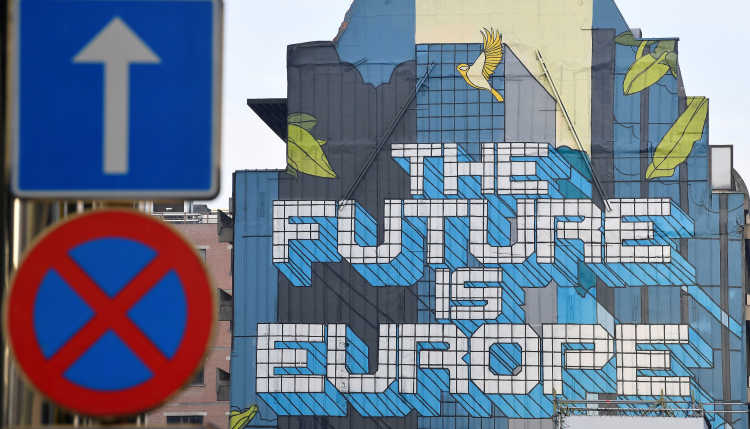
Nach ihrer Gründung im Jahr 1952 haben sowohl die Europäische Gemeinschaft für Kohle und Stahl wie auch ihre Nachfolgerin, die Europäische Union, als Modell für andere Regionalorganisationen gedient. Die jüngsten Krisen in der Europäischen Union – bezüglich Migration, der gemeinsamen Währung und des Brexit – stellen diesen Status jedoch in Frage. Während diese Krisen den Erfolg der Europäischen Union schmälern, sind Voraussagen darüber, ob das Modell der Europäischen Union bald irrelevant oder gar vom Abstieg bedroht sein wird, verfrüht.
Institutionen, die denen der Europäischen Union ähneln, verbreiten sich zunehmend in der Welt; dazu gehören autoritative Streitschlichtungsmechanismen, Generalsekretariate mit Kompetenzen zum Agendasetting und parlamentarische Versammlungen.
Diese Entwicklungen sind teilweise dem Erfolg der Europäischen Union geschuldet sowie der Tatsache, dass sie aktiv regionale Integration in anderen Teilen der Welt fördert. Die Europäische Union stärkt Regionalismus aktiv durch finanzielle und technische Unterstützung sowie durch die Verhandlung interregionaler Abkommen.
Dennoch schaffen Institutionen, die vergleichbar mit denen der Europäischen Union sind, selten gleichwertige positive Ergebnisse, weil andere Regionen sich stärker um nationale Souveränität sorgen und die wirtschaftlichen, politischen und sozialen Umfelder sich unterscheiden.
Die jüngsten Krisen in der Europäischen Union haben ihre externe Wahrnehmung als Modell für spezifische
Policy
-Regime verfälscht. Dabei erweist sich der Brexit als größtes Problem, weil er grundlegenden Widerstand gegen die Idee regionaler Kooperation als solche zum Ausdruck bringt. Die Vorstellung, dass regionale Kooperation Nationalstaaten helfen kann, Frieden zu sichern und wirtschaftlichen Wohlstand zu schaffen, wird noch immer am prominentesten von der Europäischen Union verkörpert. In einer Welt, in der Konflikte und Armut nach wie vor weit verbreitet sind, bleibt diese Idee weiterhin allgegenwärtig.
Fazit
Entscheidungsträger in Europa sollten begreifen, dass die Attraktivität des Modells regionaler Wirtschaftsintegration der Europäischen Union eine wichtige Form von soft power darstellt, und sie sollten bereit sein, diese nutzbar zu machen. Gleichzeitig hängt die fortwährende Anziehungskraft der Europäischen Union insbesondere von ihrer Fähigkeit ab, interne Probleme zu lösen und Krisen zu bewältigen – letztere stellen gegenwärtig die größte Gefahr für ihr positives Image dar.
The European Union Model of Regional Cooperation Has Spread around the World …
When a group of policymakers decided to transform Western Europe’s international relations in the mid-twentieth century in order to escape the scourge of “total war” and nationalist hysteria, they opted for a novel approach: the gradual integration of national economies under the guidance of supranational institutions. This unique approach to regional cooperation provided a “new ideology of integration” (Parsons 2002: 48) by steering a middle ground between federation – that is, the fusing of national states into a single polity with some autonomy on the part of the units themselves – and traditional forms of “loose” intergovernmental cooperation. Today, other regions have started to follow this European Union (EU) model.
Maybe the most distinctive element of the EU model is its set of supranational institutions. Three are key: the European Court of Justice (ECJ), a “trailblazer of supranational adjudication” (Hooghe et al. 2017: 589) since its inception in 1952; the European Commission, with executive competences and exclusive agenda-setting power; and, the European Parliament (EP), a body composed of (today directly elected) national parliamentarians who participate in regional decision-making. All of these institutions have spread, to different degrees and in varying combinations, to other regions around the world. Whereas they were literally unique in the 1950s, they have become more common today – even though the EU model is by no means the “standard” one of regional cooperation. The following graphs, which are based on the Measure of International Authority (MIA) dataset and cover 33 regional organisations (ROs) in the period from 1950 to 2010 (Hooghe et al. 2017), show the spread of the EU’s institutions.
Figure 1 below shows the number of organisations that shared signature institutional features with the ECJ in 2010: (a) whether an organisation featured a permanent tribunal; (b) whether private actors and other treaty bodies had access to dispute settlement; (c) whether court rulings had a direct effect; and, (d) whether there was a preliminary rulings system by which national courts could send references to the regional court. As the graph shows, there are a substantial number of ROs today that share authoritative institutional features of the ECJ – even though the number of each varies across these features. Whereas permanent tribunals by now exist in more than half of the ROs in our sample (17), rulings that have a direct effect in the legal system of member states feature in about a fourth of the ROs (8) – with private access (14) and preliminary rulings (10) located somewhere in between.
Regional policymakers do not merely copy individual elements of the ECJ, but sometimes the entire institution. Figure 2 below shows the number of organisations that share at least three of the aforementioned four institutional features of the ECJ over time. As we can see, this number has grown continuously, starting with the creation of the Andean Court of Justice in 1983. In 2010, there were 11 operational copies of the ECJ to be found across most parts of the world – a third of the sample.
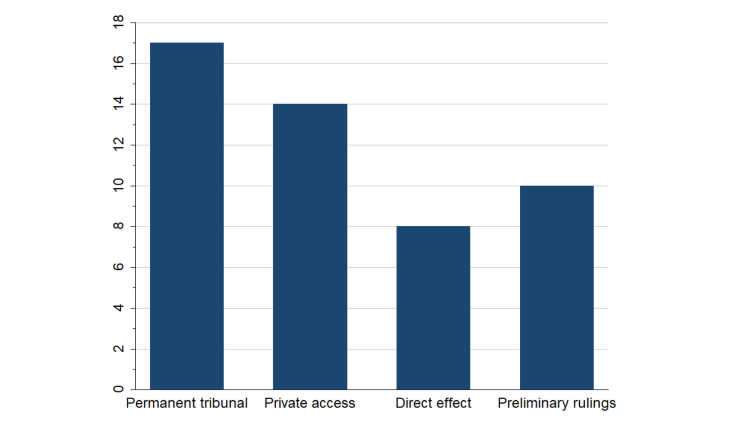
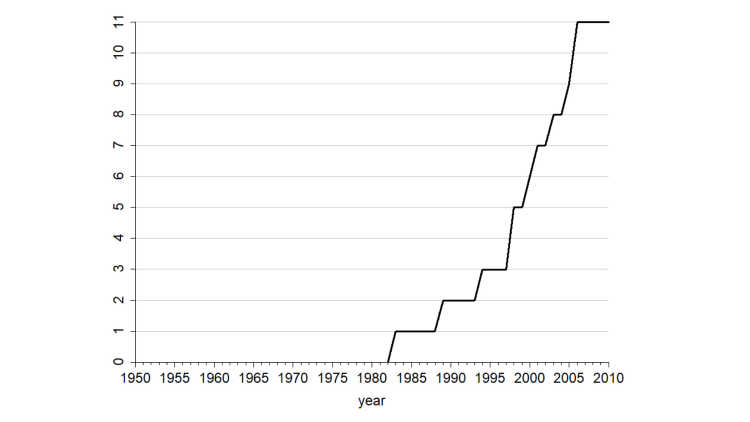
The European Commission, the second supranational institution of the EU, acts as a general secretariat and features some institutional characteristics that were unique within international cooperation in the 1950s. It not only has an exclusive right to initiate secondary legislation, but also fulfils executive tasks alongside its administrative role. The idea of the founding fathers was to establish an authoritative body that is committed to the interests of the entire organisation, not only to those of individual member states. Figure 3 below shows the number of organisations that accorded, again in 2010, the general secretariat (a) the power to initiate the adoption of secondary legislation and (b) an exclusive right to do so. We see that two thirds of ROs now accord agenda-setting competence to its general secretariats (22), while an exclusive such right is still comparatively rare (3). The Junta of the Andean Community also fell into the latter category until the Quito Protocol of 1987, which allowed member states – alongside the Junta – to submit proposals to the Commission, the decision-making organ. The three general secretariats with a monopoly to initiate secondary legislation also dispose of executive competences, and thus combine both of the signature features of the EC. All three are located in Africa (Southern African Development Community, SADC, Economic and Monetary Community of Central African States, and the Economic Community of West African States, ECOWAS). The European Commission model is less popular elsewhere than the ECJ one, however.
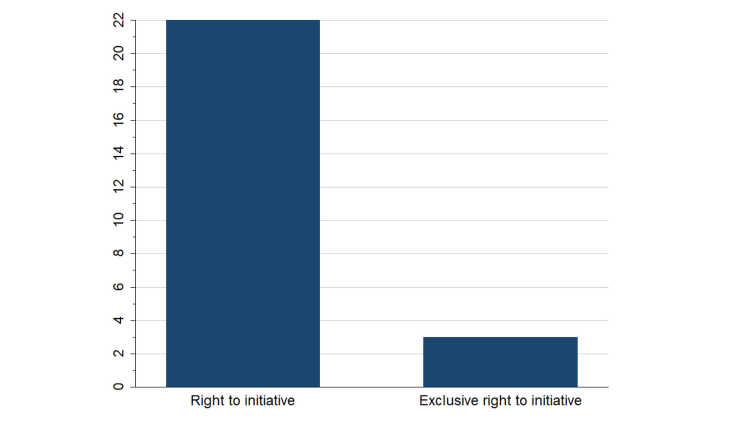
Finally, the early EU was the second organisation in the world (after the Council of Europe) that endowed not only governments but also parliamentarians with institutionalised opportunities to participate in regional cooperation. The Common Assembly of the European Coal and Steel Community was primarily designed as a counterweight to control the uniquely authoritative High Authority, but it also had consultative powers in policymaking from its inception. The story of its empowerment is well known: starting with legislative competences on the budget in the 1970s, the EP – as it has been called since 1958 – has worked to become a true co-legislator besides the Council of Ministers. Figure 4 below shows the number of ROs in 2010 that disposed of a parliamentary institution composed of elected parliamentarians (a) with consultative powers only, (b) with legislative powers, and (c) that were directly elected in at least some of its member states. The graph shows that parliamentary institutions have become widespread as consultative bodies within ROs, but EU-type institutions that have legislative competences and are directly elected are still extremely rare: only the East African Legislative Assembly has the competence to legislate, and the Andean Parliament and the Central American Parliament are directly elected.
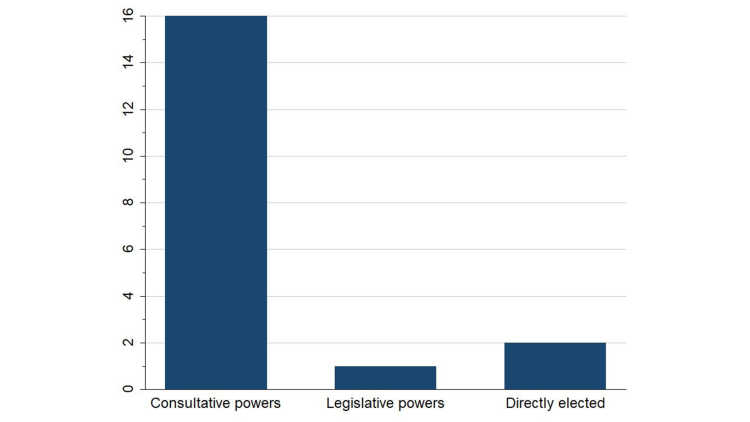
Taken together, the EU’s supranational institutions have spread to other parts of the world – wholly or in part – to various degrees. Whereas the ECJ model has become a real export hit, the European Commission and the EP remain more modest as institutional models – although ROs around the world have adopted some of their respective elements. Whereas policymakers within most ROs cherry-pick elements of the EU model to assemble their own brand of regional cooperation, SADC (before the abolition of the SADC Tribunal), the African Union, and ECOWAS have adopted most of its signature tenets.
… through EU Diffusion, Growing Interdependence, and Community
The reasons why policy-makers in other regions adopt EU-style institutions are diverse and diffusion from the EU is only one factor, which comes in two forms (see Lenz and Burilkov 2017).
The first such form is active EU diffusion. Born out of its own experience with regional cooperation and integration in bolstering peace and improving the prosperity of member states, European policymakers already began in the 1960s to support regional cooperation among their former respective colonies in Africa. Interregional cooperation with the group of African, Caribbean, and Pacific states sought to foster regional cooperation among those states themselves. This policy was extended in the 1970s and 1980s to existing ROs in Asia (Association of Southeast Asian Nations, ASEAN), Latin America (Andean Pact, Integration System of Central America), and the Middle East (Gulf Cooperation Council). Today, the EU has regular interaction with many ROs around the world, and it continues to maintain interregional contacts with regions that do not have a formal representative organisation – such as the Barcelona Process with the Mediterranean countries, or the Asia–Europe Meeting (ASEM). Within these interregional contexts, the EU has advertised the “lessons” of European integration to other organisations that have been willing to listen – with it actively seeking to export its model of institutionalised regional cooperation.
The toolbox that the EU uses for this purpose encompasses a number of foreign policy instruments. As part of the Community’s development policy, the European Commission provides financial and technical assistance to strengthen regional cooperation. For example the Commission has supported the strengthening of ASEAN’s general secretariat, and it helped to build the SADC’s Tribunal (Lenz 2012) – which was inaugurated in 2005 and then dismantled again after a controversial ruling in 2013 (Nathan 2013).
As part of the Community’s trade policy, meanwhile, it negotiates cooperation and trade agreements with other ROs or groups of countries in an attempt to strengthen regional market-building. Negotiations with the Southern Common Market (Mercosur) – a RO in South America – over an interregional trade agreement, which started in the late 1990s and continue to this day, are a prominent example. And, as part of its Common Foreign and Security Policy, the Community conducts interregional political dialogues with other organisations and groups of countries in order to strengthen political cooperation and coordinate joint positions on international issues.
The second form of influence is passive EU diffusion. The emulation of the EU’s institutions and policies does not require active promotion, with the European experience existing for everyone to see and learn from. As Pascal Lamy, a former commissioner of trade, once quipped: “Regionalism may be a European invention, but it is not protected by copyright law!” (Lamy 2001). Especially when institutional designs seem successful in solving cooperation problems, they can serve as institutional templates for other organisations facing similar challenges. The EU is widely considered the most successful RO in the world, and it has attracted many proponents globally. One example that I have personally studied is a Filipino parliamentarian, José de Venecia, who has worked relentlessly for the establishment of a parliamentary institution akin to the EP within ASEAN for the past three decades. With the ASEAN charter and subsequent developments, the parliamentary institution – which has existed as an independent body since the 1970s – achieved formalised access to the organisation’s decision-making processes (Lenz, forthcoming). Such passive EU diffusion can be self-reinforcing. As more and more organisations adopt EU-type institutions, ideas about the appropriate institutional design for a RO are updated; this also increases pressure on other organisations to adapt as well.
Active and passive diffusion are not the only reasons for the spread of EU-style institutions, which still feature among the most authoritative in the world of international cooperation. There are at least two other conditions that have facilitated movement towards strong regional institutions, and these are related to the structural environment in which regional cooperation is embedded. The first facilitating condition is growing interdependence between states. Globalisation implies that governments are finding it increasingly difficult to solve problems by themselves. Consider how issues as diverse as economic growth, peace and security, or clean air spill across national borders and require international cooperation. Under conditions of interdependence, more authoritative institutions may be functionally desirable to maintain or improve the effectiveness of ROs – because such institutions have the capacity to facilitate intergovernmental bargaining, to generate policy-relevant expertise, and to monitor compliance with decisions. Once regional institutions, which help states to manage interdependence, reach a certain level of authority they start resembling those of the EU.
The second facilitating condition is community (Hooghe, Lenz, and Marks, forthcoming). Groups of states that share common norms find it easier to cooperate on the basis of highly incomplete contracts; that is, treaties that stipulate only the goals of cooperation rather than specific means and concrete measures. For example, the North American Free Trade Agreement – with its more than 1,000 pages of text – is a relatively complete contract, whereas the three-page Bangkok Declaration that founded the ASEAN forms a highly incomplete one. Incomplete contracts are easier to adjust to unforeseen circumstances, and they provide more scope for institutional evolution. In fact, incomplete contracting requires institutional evolution in line with the shifting content of cooperation. Yet, their incompleteness generates ambiguity about whether an action conforms to the contract or not. Only member states that share common norms are willing to enter into such contracts because they are less fearful of neighbours that may exploit the ambiguity inherent in incomplete contracting. As such, normative commonality through incomplete contracting facilitates the creation of more authoritative regional institutions that may eventually resemble those of the EU.
But EU-Type Institutions Function Differently in Different Parts of the World
The fact that ROs in other parts of the world have, to varying degrees, adopted EU-style institutions does not mean that they have become “mini-EUs” in reality. Institutional practices and outcomes continue to be diverse across the world, and many ROs have been less successful than the EU – especially when it comes to liberalising trade, the core purpose of many of these organisations. Expert surveys indicate that the EU is still, by some margin, the most effective regional trade organisation in the world, with most ROs in the Global South lagging behind (Gray and Slapin 2012).
Why, then, do EU-type institutions often not translate into EU-type practices and outcomes? The reason for this is intuitive: even if policymakers adopt EU-type institutions, these do not enter into a vacuum elsewhere but rather meet pre-existing local conditions and historical experiences, which shape their operation. As such conditions and experiences vary across regions, EU-type institutions do not produce EU-type outcomes. I want to highlight two conditions (see Lenz 2013: 218–219).
The first important difference is attitudes towards national sovereignty. In Europe, the unfettered pursuit of national sovereignty was widely discredited after the unprecedented destruction of World War Two, while governments in the 1950s and 1960s were aware that only by pursuing far-reaching regional cooperation would they be able to “rescue the nation state” (Milward 1992). This was particularly true of Germany, the largest and most powerful West European state. Germany’s unprecedented willingness to share national sovereignty with its neighbours in order to facilitate regional cooperation can only be understood against this unique historical background.
The historical context in other regions is very different. Not only were most states elsewhere spared the experience of events as destructive as World War Two (even though many countries were affected by it), and with it having less willingness to share national sovereignty in the pursuit of “national survival.” The postcolonial context, in which many of these states are embedded, also means that states in other parts of the world rarely perceive supranational institutions as opportunities to “regain” national sovereignty by pooling it but as outright threats to such sovereignty in fact. Thus ROs regularly deprive EU institutions of their most authoritative features when adopting them, such as by endowing parliamentary institutions with consultative rather than legislative competences. Some of the institutional similarities between other ROs and the EU are rather superficial, then. Where EU institutions have travelled more wholesale in terms of formal competences, member states may still use informal channels to inhibit EU-type functioning. For example, patrimonial networks in staffing decisions or a deliberate lack of financial resources being provided hamper the functioning of regional institutions in many parts of the world presently (Gray 2018).
Beyond divergent historical experiences, structural reasons also explain continued differences in the institutional practice of regional cooperation between the EU and other world regions. The relative lack of economic complementarity between member states as well as limited domestic capacity have been cited as reasons for why other regions generally lag behind the EU vis-à-vis the successful undertaking of economic cooperation, even if they pursue similar objectives (Mattli 1999; Gray 2014). Recent research on the functioning of regional courts has furthermore identified the societal conditions that facilitate the form of expansionist law-making that characterised legal integration in the EU, and contributed much to the success of European integration. Regional courts tend to be more expansionist in their rule-making when there are sub-state and societal interlocutors – such as national judiciaries, advocacy networks, and administrative agencies – that encourage such an expansive interpretation of formal competences on the part of judges and facilitate compliance with courts’ rulings. Whereas the Andean Court of Justice is an institutional copy of the ECJ, for example, it has been much more protective of national sovereignty in its rulings due to different societal conditions (Alter and Helfer 2010).
And the Future? EU Crises and the Attractiveness of its Model
EU-type institutions have seldom produced similar institutional practices and outcomes, yet the EU nevertheless has still served as a model – or an inspiring example – in many parts of the world for a long time now. What are the consequences of the current EU crises for such perceptions, then? An answer to this question is necessarily speculative, but I want to suggest that different types of crisis have different repercussions for the attractiveness of the EU model abroad. Whereas the EU’s policy crises have tainted its image as a successful organisation only temporarily, Brexit – the United Kingdom’s impending withdrawal from the EU – constitutes a more fundamental challenge because it questions the EU’s very mode of integration. Much of the critique by the advocates of Brexit (“Brexiteers”) is shared by a significant section of the population in respective EU member states, including some of its core countries.
Over the past decade, the EU has had to contend with a number of major challenges that have triggered heated debates within the EU’s institutions and many of its member states – colloquially, these challenges have been referred to as “crises.” One of these challenges was the European debt crisis, or Euro crisis – a multi-annual difficulty of several European countries (Cyprus, Greece, Ireland, Portugal, and Spain) in repaying their government debt or in bailing out over-indebted banks. Another crisis was related to large movements of refugees and migrants from the Middle East and Africa to Europe (“migration crisis”). Finally, there is the Brexit limbo, which – if it does ultimately happen – would be the first time since the beginning of European integration that a member state has ever left the Union.
These crises have tainted the EU’s image as a successful RO because they appeared to put an end to, first, a long phase of relatively “smooth” functioning since the early 1990s – when the UK was forced to leave the European Exchange Rate Mechanism in preparation for the introduction of the Euro – and, second, the continued attractiveness of membership in the EU. This was indicated by the enlargement to 10 Central and Eastern European countries throughout the first decade of the new millennium. These crises were widely picked up on in other parts of the world, and they indicate to many outside observers that the EU is facing severe challenges – testing its ability to find workable compromises on some of its core issues. Thus, the EU’s external image strongly depends on whether it will be able to “solve” these key underlying problems.
In particular, it became clear to outside observers that two important policy regimes – the common currency and Europe’s policy on migration – are inoperable as currently conceived. The Euro crisis revealed that a currency union without a fiscal union, meaning a common tax and fiscal policy, is difficult to maintain in the long run because it deprives national governments of an important policy tool to respond to crises (monetary policy) while also hampering their ability to respond jointly at the supranational level due to a lack of suitable instruments. Similarly, the migration crisis showed that the Dublin Convention of 1990 – which regulates the asylum process in the EU and marks the external counterpart to the internal free movement stipulations of the Maastricht Treaty (“Schengen”) – distributes the burdens of asylum-seeking highly unevenly across EU member states as it requires such individuals to make their application to stay in the first country that they arrive in. Even though both of these policy crises have difficult structural problems at their heart, the EU has been able to manage them by muddling through while trying to agree upon more sustainable solutions in the medium term. To the extent that the EU is able to find such solutions, these policy crises have not damaged the EU’s image irreparably so far.
However, finding solutions to these problems is increasingly tied up with the EU’s ability to engineer consensus on what are domestically highly contested policy issues – and this capacity is steadily deteriorating with the ongoing rise of right-wing populist parties in many EU member states. These new political actors contest European integration not for its inability to find appropriate policy solutions to important political problems – a characteristic of much of the left-wing criticism of the EU – but rather the authority of the EU and other international organisations even in principle (see Hooghe, Lenz, and Marks 2018). In a speech launching her campaign for the 2017 presidential race, Marine Le Pen made globalisation the enemy – linking it to Islamist fundamentalism as a force that will “subjugate our country” and “make our nation disappear.” Le Pen promised to pull France out of the Eurozone, the North Atlantic Treaty Organization, and, more generally, to regain “our territorial sovereignty” (cited in Hooghe, Lenz, and Marks 2018: 7). Not only Le Pen and the French National Rally, but also other political actors on the populist right such as Matteo Salvini and the Northern League in Italy or Geert Wilders and the Party for Freedom and Progress in the Netherlands reject international organisation both in principle as well as in practice. Hungarian prime minister Viktor Orban recently reiterated to the German daily newspaper Bild his objections to the EU’s migration policies, by arguing that they threaten the “sovereignty and cultural identity” of Hungary meanwhile.
Despite crises and difficulties, most of the EU’s history was characterised by a pragmatic attitude towards sovereignty according to which governments were willing to pool it in the interest of joint gains. Today, populist right-wing parties – whose rise is only likely to continue – display a more principled attitude that regards national sovereignty as indivisible. This is also at the core of the Brexiteer agenda, which was successful in mobilising more than half of the UK’s electorate around the idea to “take back control” – as the catchy slogan has it – by leaving the EU. While the UK has long been the most Eurosceptic of EU member states, the rise of right-wing populism in many EU countries indicates that this core idea falls on fertile political grounds not only in that one alone. To the extent that this attitude gains further ground going forward, the process of European integration as it has progressed previously is unlikely to continue.
What does this mean for the continued attractiveness of the EU model? Despite these difficulties, predictions of the irrelevance and imminent demise of the EU model are premature. The historic achievements of the EU in contributing to peace and prosperity in its member states are seen more clearly beyond its shores than in some political milieus within it. Even though the EU is undergoing its most profound “crisis of external image” to date, the idea that regional cooperation can help nation states to secure peace and enhance economic welfare will remain attractive – and the EU will continue to be its most prominent example.
This image is a resource in the EU’s foreign policy that policymakers would do well to tap into. It endows the EU with credibility not only in its worldwide promotion of regional cooperation, but also in its efforts to strengthen multilateralism more broadly. The EU remains a microcosm of how countries with different historical experiences, economic and social structures, as well as varying preferences can cooperate to the benefit of all through a sophisticated system of both negotiation and compromise. In this respect, the EU may serve as a promising example in a world in which material inequality and normative divergence too often impair much-needed global cooperation. Yet, fulfilling this potential also entails keeping the EU’s own house “in order.” The attractiveness of the EU model depends, then, on the Union’s continued ability to solve difficult cooperation issues and to cope with crises that threaten its very unity. Especially in the current political climate in Europe and elsewhere, in which a cooperative attitude between governments cannot be taken for granted, being able to maintain productive international cooperation would send a particularly strong sign that negotiation and compromise are worthwhile, and indeed vital, undertakings.
Fußnoten
Literatur
Alter, Karen, and Laurence Helfer (2010), Nature or Nurture? Judicial Lawmaking in the European Court of Justice and the Andean Tribunal of Justice, in: International Organization, 64, 4, 563–592.
Gray, Julia, and Jonathan Slapin (2012), How Effective Are Preferential Trade Agreements? Ask the Experts, in: Review of International Organizations, 7, 3, 309–333.
Gray, Julia (2014), Domestic Capacity and the Implementation Gap in Regional Trade Agreements, in: Comparative Political Studies, 47, 1, 55–84.
Gray, Julia (2018), Life, Death, or Zombie? The Vitality of International Organizations, in: International Studies Quarterly, 62, 1, 1–13.
Hooghe, Liesbet, Gary Marks, Tobias Lenz, Jeanine Bezuijen, Besir Ceka, and Svet Derderyan (2017), Measuring International Authority: A Postfunctionalist Theory of Governance, Oxford: Oxford University Press.
Hooghe, Liesbet, Tobias Lenz, and Gary Marks (2018), Contested World Order: The Delegitimation of Global Governance, in: Review of International Organizations, 1–13, https://doi.org/10.1007/s11558-018-9334-3.
Hooghe, Liesbet, Tobias Lenz, and Gary Marks (2019), A Theory of International Organization, Oxford: Oxford University Press (forthcoming).
Lamy, Pascal (2001), Regionalism and Multilateralism in Latin America, Speech given at the Federation of Industries of the State of Sao Paolo, Sao Paolo, 10 July.
Lenz, Tobias (2012), Spurred Emulation: The EU and Regional Integration in Mercosur and SADC, in: West European Politics, 35, 1, 155–174.
Lenz, Tobias (2013), EU Normative Power and Regionalism: Ideational Diffusion and Its Limits, in: Cooperation and Conflict, 48, 2, 211–228.
Lenz, Tobias, and Alexandr Burilkov (2017), Institutional Pioneers in World Politics: Regional Institution Building and the Influence of the European Union, in: European Journal of International Relations, 23, 3, 654–680.
Lenz, Tobias (2019), EU Entrepreneurship, Norm Diffusion and the Creation of Regional Parliamentary Assemblies, in: Kolja Raube, Meltem Müftüler-Baç and Jan Wouters (eds), Parliamentary Cooperation and Diplomacy in EU External Relations, Cheltenham: Edward Elgar (forthcoming).
Mattli, Walter (1999), The Logic of Regional Integration: Europe and Beyond, Cambridge: Cambridge University Press.
Milward, Alan (1992), The European Rescue of the Nation State, London: Routledge.
Nathan, Laurie (2013), The Disbanding of the SADC Tribunal: A Cautionary Tale, in: Human Rights Quarterly, 35, 4, 870–892.
Parsons, Craig (2002), Showing Ideas as Causes: The Origins of the European Union, in: International Organization, 56, 1, 47–84.
Gesamtredaktion GIGA Focus
Redaktion GIGA Focus Global
Lektorat GIGA Focus Global
Regionalinstitute
Forschungsschwerpunkte
Wie man diesen Artikel zitiert
Lenz, Tobias (2018), Die Europäische Union: Ein Modell unter Druck, GIGA Focus Global, 6, Hamburg: German Institute for Global and Area Studies (GIGA), http://nbn-resolving.de/urn:nbn:de:0168-ssoar-61007-5
Impressum
Der GIGA Focus ist eine Open-Access-Publikation. Sie kann kostenfrei im Internet gelesen und heruntergeladen werden unter www.giga-hamburg.de/de/publikationen/giga-focus und darf gemäß den Bedingungen der Creative-Commons-Lizenz Attribution-No Derivative Works 3.0 frei vervielfältigt, verbreitet und öffentlich zugänglich gemacht werden. Dies umfasst insbesondere: korrekte Angabe der Erstveröffentlichung als GIGA Focus, keine Bearbeitung oder Kürzung.
Das German Institute for Global and Area Studies (GIGA) – Leibniz-Institut für Globale und Regionale Studien in Hamburg gibt Focus-Reihen zu Afrika, Asien, Lateinamerika, Nahost und zu globalen Fragen heraus. Der GIGA Focus wird vom GIGA redaktionell gestaltet. Die vertretenen Auffassungen stellen die der Autorinnen und Autoren und nicht unbedingt die des Instituts dar. Die Verfassenden sind für den Inhalt ihrer Beiträge verantwortlich. Irrtümer und Auslassungen bleiben vorbehalten. Das GIGA und die Autorinnen und Autoren haften nicht für Richtigkeit und Vollständigkeit oder für Konsequenzen, die sich aus der Nutzung der bereitgestellten Informationen ergeben.















